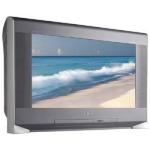
Available Sizes:Sizes 9" - 40"
Advantages:
The image quality is excellent - in many ways superior to other newer technologies.
The prices are affordable - Many tube sets cost way less than flat panel competitors.
Familiar technology - Who hasn't owned a tube TV at one point or another?
Excellent Viewing Angles - You can see the image from nearly any angle.
Disdvantages:
Sizes are limited - If you want an immersive experience, but sit more than 6 feet away, forget the tube and move to a different technology.
Weight - The largest tube TVs can weigh in over 250 pounds!
Depth - Most tube TVs range between 18-24 inches deep.
Cost - The largest tubes often cost more than other larger display types.
Since the beginning of television, there has been cathode-ray tube (CRT) technology. The CRT, though more refined today than in the early twentieth century, has operated on the same basic principles since the first TVs were unveiled.
Analog shoppers are drawn to this market, since this is where the majority of analog choices remain. Analog tubes are not much different from the ones you've owned in the past, but newer refinements, like flat screens, can give you a much sharper image than what you've experienced before. These are also the cheapest choice, with manufacturers practically giving these things away at low-ball retail prices. Digital tube TVs are significantly more expensive than their analog counterparts.
Performance shoppers tend to levitate to tubes given their superb image quality. Many tubes achieve rich black levels, high resolutions, and vivid colors, while beating out many of the newer types of TVs.
However, tubes are not perfect either. Tube TVs require some kind of stand to put it on, which increases overall cost if you don't already have one. They're also extremely heavy, making them difficult to move if the need arises.
Cosmetics are often a complaint, since we live in a world where thin is in. Tube TVs are generally 18 to 24 inches deep, making them jut out into the living room and take up additional floor space.
The biggest problem with tube TVs is their screen size, which is severely limited. If you want anything bigger than 38 inches widescreen, you'll need to look beyond tube TVs to get it.
Return to Understanding the Different Types of TVs




